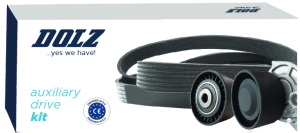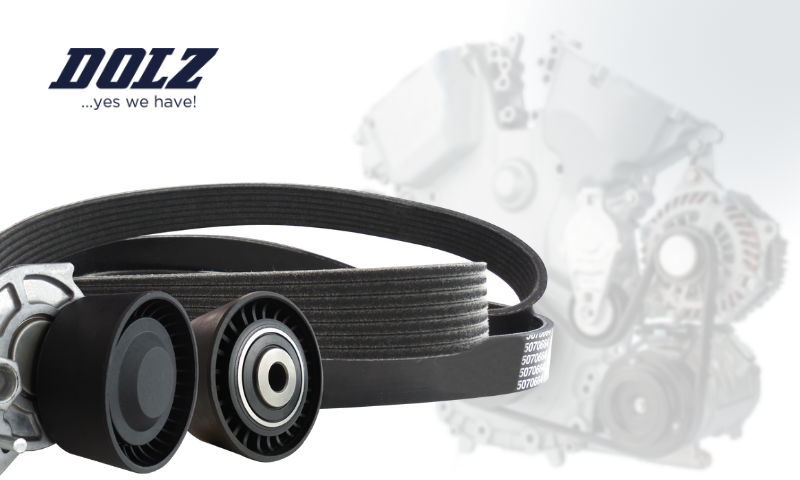The auxiliary drive belt, also named serpentine belt or poly-v belt, is a drive belt that works with the idlers, tensioners and pulleys within the accessory drive belt system.
This belt should not be confused with a timing belt, which serves a completely different purpose. While the timing belt keeps the crankshaft and camshaft in sync., the auxiliary drive belt is what keeps the engine accessories running smoothly and efficiently.
Auxiliary drive belt: What is it?
An auxiliary drive belt consists of a long rubber belt that propels power to engine components via a system of pulleys that are driven by the main crankshaft pulley. These engine components include the alternator, the aircon compressor, the power steering pump and sometimes the water pump.
Its wide, flat, and often toothed design makes it a requisite for today’s engines, as it can power different accessories at once. This is essential in modern engine bays where space is restricted, as opposed to multiple drive belts used mostly in outdated car models.
Keep reading: Understanding timing belt components and how to maintain it
Poly-V belts are now made of high-quality reinforced rubber, (EPDM) Ethylene Propylene Diene Monomer rubber ensuring a long service life. Although like timing belts, these are also subject to wear, so they will deteriorate over time.
As the auxiliary drive belt is naturally long, it is wise to have idler pulleys and/or a tensioner pulley in it. These keep the belt tensioned so that it does not deviate from its direction, and so that it applies the exact friction to the pulleys.
What happens to a car when the auxiliary belt breaks?
When a car’s auxiliary drive belt breaks, all the accessories that depend on it will stop working or not work as they should, from power steering loss to A/C escape, battery breakdown and engine overheating,
Unlike the timing belt, a broken poly-v belt will not cause catastrophic engine damage.
Problems associated with auxiliary drive belts
Serpentine belts can fail in different ways. The most serious complications occur when the drive belt breaks completely. This is usually the result of a belt in poor condition, or a problem associated with one of the components being driven by the belt; for example, a failed bearing in a pulley.
Consequences of a malfunctioning aux belt
Failure in an auxiliary drive belt can cause many different consequences on your engine and can be potentially dangerous. When inspecting the auxiliary drive belt system, pay attention to the following signals to confirm if the drive belt needs to be replaced:
- Difficulty in steering the vehicle or no power steering at all.
- Engine overheating and unstable marks showing on the temperature gauge.
- A malfunctioning air conditioning with no cool air blowing out from the vents.
- A dying battery that will eventually die without the alternator’s charge.
- Squealing sounds in the front area of the car and/or a whine from the engine.
Signs of a malfunctioning auxiliary drive belt
When inspecting the poly-v belt, pay attention to the following indicators in order to confirm whether the drive belt needs replacement:
- Deep cracking and wear in the ribs and spine of the belt.
- A shiny, glazed and/or frayed appearance showing signs of age.
Keep learning: Car temperature: Key aspect in a vehicle’s performance
- A hardened surface showing a substantial loss of flexibility.
- Belt contamination with oil or coolant due to other vehicle issues.
Although all these potential issues can be easily detected during a routine inspection, every auxiliary belt car has its unique characteristics. For instance, an EPDM belt will not crack like traditional neoprene rubber belts and will need to have the rib valleys inspected with a belt wear gauge. So, take each individual model into consideration.
Dolz: the perfect dealer of auxiliary drive belts
Dolz has been providing top-notch, OE-equivalent parts for passenger cars, trucks and commercial vehicles since 1934. With nearly 90 years of knowledge and experience, our presence has now expanded to more than 70 countries around the world.
Following our mission and completing our wide range of transmission products, we recently introduced our range of auxiliary drive kits available for dealers and workshops around the globe. Designed and produced following OE specifications, our kits offer greater engine performance and comfort.
In order to make your life easier and to secure effortless replacements, these kits include all the necessary components for a professional repair, all in one single package:

- V-ribbed belt or auxiliary drive belt
- Pulleys and idlers
- Drive tensioners
- All the necessary accessories when needed.
Contact us so that we can facilitate a tailored solution, as well as guidance throughout the whole selection process.


